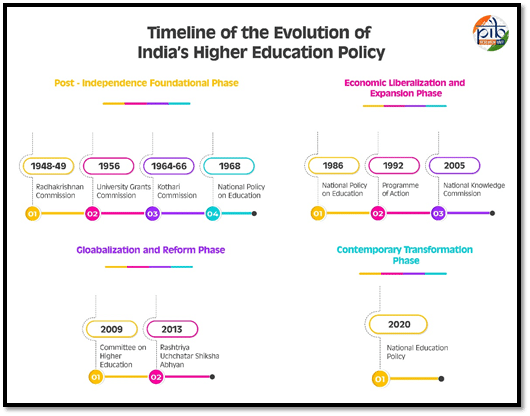Growth of Higher Education in India

India’s higher education landscape has undergone a remarkable transformation over the past few decades. From a system that struggled with low enrollment and limited access, it has evolved into a vibrant ecosystem that serves millions of students. This article explores the significant advancements in India’s higher education sector, focusing on enrollment growth, the expansion of State Public Universities (SPUs), and the increasing representation of disadvantaged groups.
Historical Context of Higher Education in India
At the time of India’s independence in 1947, the education system faced numerous challenges. The country had only 17 universities and 636 colleges, catering to approximately 238,000 students. The literacy rate was a mere 14%. Fast forward to today, and the scenario has drastically changed. India now boasts 495 State Public Universities and over 46,000 affiliated institutions. These universities play a crucial role in making higher education accessible to a broader population. They account for 81% of total student enrollment, significantly contributing to the educational landscape across the nation.
The National Education Policy (NEP) 2020 aims to double enrollment by 2035, indicating a commitment to further expanding access to quality education. This policy is particularly focused on enhancing the capabilities of SPUs, which have been instrumental in reaching students in remote and underserved areas. The growth of these institutions is a testament to India’s dedication to improving its education system and ensuring that knowledge is accessible to all.
Enrollment Trends and Growth in Higher Education
India’s higher education sector has witnessed impressive enrollment growth over the years. According to the latest reports, enrollment in State Public Universities increased from 23.4 million students in 2011-12 to 32.4 million in 2021-22. This growth reflects a broader trend of increasing access to higher education across various demographics.
The enrollment of students from socially and economically disadvantaged groups (SEDGs) has also seen significant improvements. For instance, enrollment among Other Backward Classes (OBCs) rose by 80.9%, while Scheduled Caste (SC) enrollment grew by 76.3% during the same period. The percentage of eligible SC students enrolled in higher education increased from 15% to nearly 26%. Similarly, Scheduled Tribe (ST) enrollment doubled, highlighting the progress made in including marginalized communities in the educational framework.
The Gross Enrollment Ratio (GER) in India has also shown remarkable growth, increasing from 0.4 in 1950-51 to 28.4 in 2021-22. This growth aligns with the NEP 2020’s goal of achieving a GER of 50% by 2035, emphasizing the government’s commitment to expanding educational opportunities for all.
The Role of State Public Universities
State Public Universities (SPUs) have emerged as a cornerstone of India’s higher education system. They play a vital role in making education accessible, especially in rural and remote areas. The recent report by NITI Aayog highlights the importance of SPUs in serving over 32.5 million students. These institutions are crucial for implementing the National Education Policy’s objectives, which aim to enhance the quality and reach of higher education.
The growth of SPUs has been significant, with their enrollment numbers increasing substantially over the past decade. They have become the primary choice for many students, accounting for a large share of total enrollments. This trend underscores the importance of SPUs in democratizing education and ensuring that students from diverse backgrounds can pursue higher studies.
Moreover, SPUs have been instrumental in promoting gender parity in education. The Gender Parity Index (GPI) for 2021-22 stands at 1.01, indicating progress toward gender equality in higher education. This achievement reflects the ongoing efforts to create an inclusive educational environment that empowers all students, regardless of their gender.
India’s Global Research Contribution and Future Prospects
India’s contribution to global research has also seen a significant rise. The country’s share of global research publications increased from 3.5% in 2017 to 5.2% in 2024. This growth is particularly evident in institutions like the Indian Institutes of Technology (IITs), which lead in research output, contributing over 24% of total publications. Private deemed universities are also making strides, accounting for about 23.5% of total research publications.
Investment in higher education has been a priority for the Indian government. In 2021, India dedicated 1.57% of its Gross Domestic Product (GDP) to tertiary education, surpassing many European nations. This investment is crucial for expanding and strengthening the education ecosystem, ensuring progress in both research and access to quality education.
Looking ahead, the National Education Policy (NEP) 2020 aims to further enhance the higher education landscape in India. With a focus on improving infrastructure, faculty development, and research capabilities, the government is committed to ensuring equitable access to quality education for all students. The future of higher education in India looks promising, with continued growth and development on the horizon.
Observer Voice is the one stop site for National, International news, Sports, Editor’s Choice, Art/culture contents, Quotes and much more. We also cover historical contents. Historical contents includes World History, Indian History, and what happened today. The website also covers Entertainment across the India and World.

